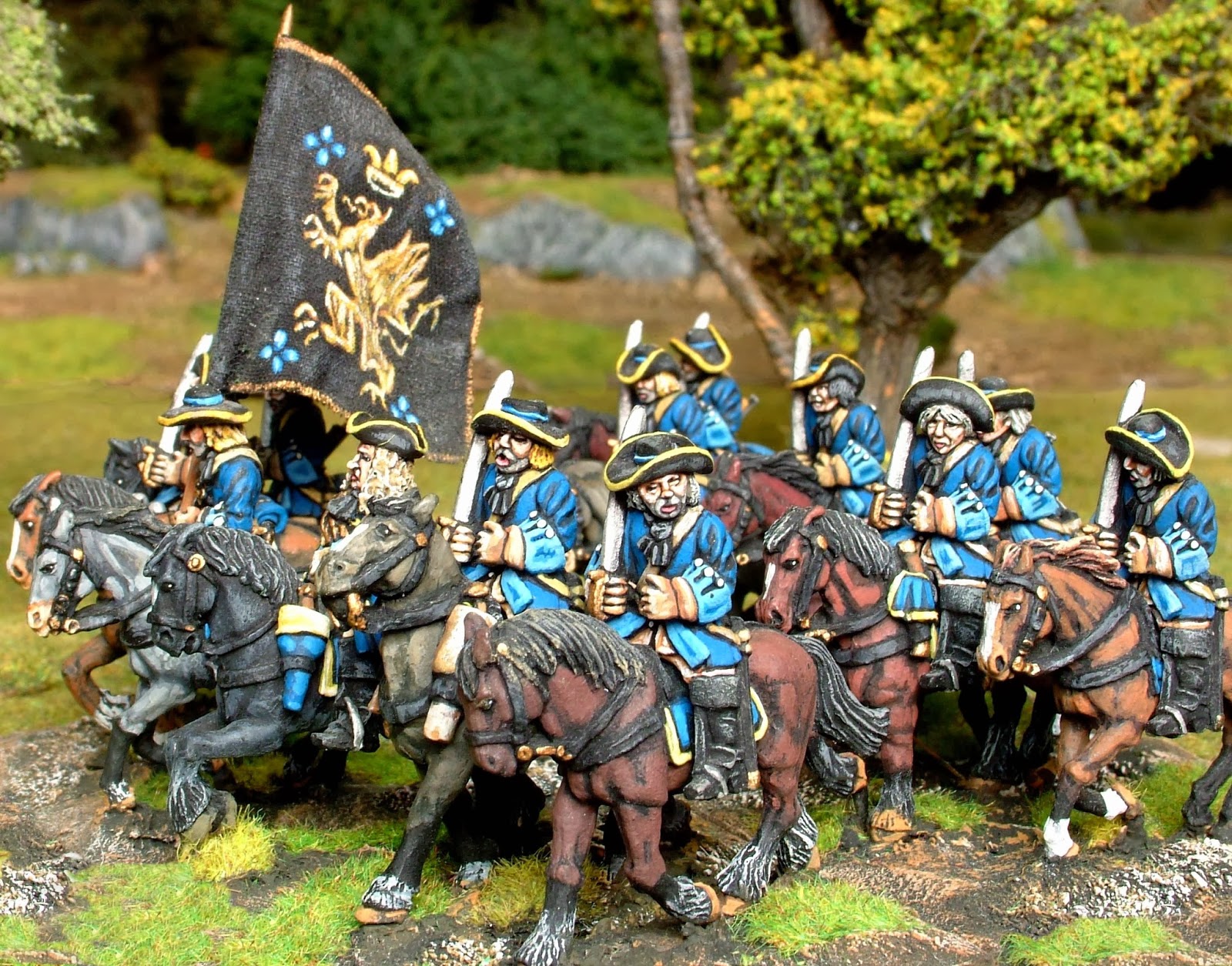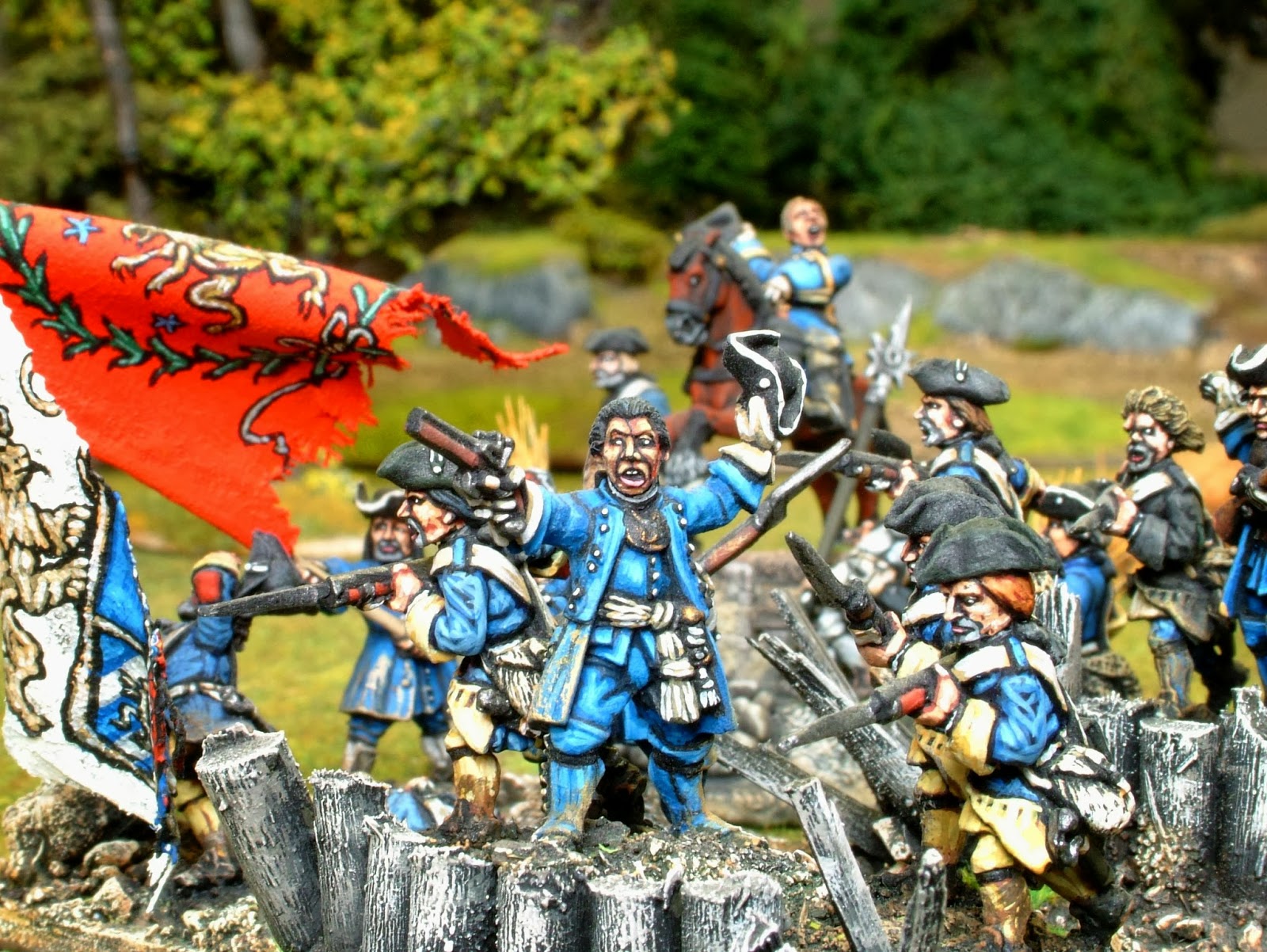Andreas describes the historical action in part 2...
The
Battle of Helsingborg
Early on the morning of February 28 the
Swedish army started to move west towards the sea for a few kilometers and then
turned south. The army formed into five columns ready to attack the Danish
army. Rantzau was also up early that morning and formed his army facing
northeast, the most likely facing of the Swedish attack. The terrain in front
of the Swedish army was not the best; it was full of frozen swamps, deep
ditches and low stonewalls. A thick fog concealed the armies from each other
and it came as a surprise for both Stenbock and Rantzau when the Swedish army
around 10 o’clock in the morning appeared to the left of the Danish army. The
Swedish right flank of cavalry stretched far beyond the Danish positions formed
on the slopes of the Ringstorp Heights. Rantzau immediately ordered his army to
turn towards the position of the Swedish army. He positioned his artillery, 12
pieces of different calibers, on the Ringstorp heights along with 29 squadrons
of cavalry. In the Danish center, formed around the small village of Berga, was
the Danish infantry. Sixteen battalions of infantry formed in two lines behind
a line of cheval-de-frise to protect them from cavalry
attacks. On the right flank 29 squadrons and 2 battalions were still trying to
get into position. With them was also Rantzau, doing his best to bring order to
the chaos that had erupted.
Stenbock was also surprised by the Danish
formation and as his battalions and squadrons started to form a battle line,
they started to slightly turn left to better meet the Danish army. The Swedish army had 60 squadrons equally
distributed on each flank of the 22 battalions strong center. Stenbock also had
34 cannons, although of lighter calibers than the Danes. The two armies were
roughly the same size with about 14 000 man fighting on each side. The Swedish
turn to the left was perceived as an attempt to out-flank the Danish right
flank. Rantzau decided to counter this by ordering his whole right flank to
advance. This on the other hand was perceived as an advance by the regiments in
the center, which slowly started to advance, causing a wide gap between the
center and the right flank of the Danish army.
The first contact was made far on the right
of the Danish battle line as the cavalry of the Danish right flank surprised
the cavalry of the Swedish left flank. A fierce battle took place around the
village of Brohusen were numerical inferior Swedish squadrons were beaten back
by guard cavalry regiments of the Danish army. Reinforcements from the second Swedish line
were soon ordered in to the fight and they soon started to win ground. Stenbock
withdrew a few of the cavalry regiments from his right flank to support the
attack on the other flank. Rantzau himself carelessly threw himself into the
fighting and was soon wounded with a shot through his lung. Unable to command
he was escorted back to Helsingborg and later in the day evacuated to Denmark.
Without their commander and facing growing numbers of Swedish cavalry squadrons
the Danish right flank soon collapsed. The remaining soldiers fled towards
Helsingborg and some of the Swedish cavalry chased them all the way to the city
walls.
In the meantime the Swedish infantry in the
centre had traversed the difficult ground in front of the Danish line and with
their battle cry “With the help of God and Jesus!” they attacked the Danish
positions. The Danish battalions fired a constant fire but the shock of the
Swedish pikes and bayonets were too much for the leaderless Danish army. The
fight was bloody and many fell on both sides. Eventually the Danish line broke
and the battalions started to retreat towards Helsingborg. The only regiments
that stood their ground were the Danish Foot Guards and the Grenadier Corps.
Their positions on both flanks of the centerline occupied the Swedish
battalions long enough to let several of the Danish battalions reach the safety
of Helsingborg. Of the three battalions that attacked the foot guard battalion
they all reported around a third killed or wounded after the battle bearing
witness to the ferocity of the fighting.
At the same time as the Foot Guards fought
on the right flank the attack on the left flank was well underway. The Danish
left flank was severely weakened as two cavalry regiments had been ordered to
reinforce the right flank but had been caught up in the panic and also fled to
Helsingborg. Although this was also the case with the Swedish right flank
facing them the Swedes were still numerically superior to their Danish foes.
The Swedish squadrons had been harassed by cannon fire from the Danish
batteries on the Ringstorp Height and suffered several casualties but had stood
their ground. The Swedish attack started once a gap between the Danish right
flank and the center arose. The Swedish squadrons rode around the Ringstorp
height to attack the remaining Danish forces in the rear. They were met by some
Danish squadrons who quickly broke and fled towards Helsingborg. Instead of
pressing home the attack the Swedish squadrons pursued the Danes towards
Helsingborg. This meant that the remaining Danish Grenadier corps could
continue the fight. The corps was attacked by two Swedish regiments but stood
their ground for some time before they retreated back to Helsingborg in good
order. Casualties were high on both sides.
Aftermath
The battle was over around 3 o’clock in the
afternoon and the battle had lasted for no more than an hour and a half.
Smaller skirmishes were still being fought during the afternoon as isolated
Danish troops were trying to get back to Helsingborg. The Danish army had lost
the battle and more than 5 000 men were dead or wounded and some 2 500 had been
captured. The Swedish army counted around 900 dead and some 2000 wounded but
had won the battle. The Swedish army was too weak to besiege Helsingborg and
instead made camp outside of the city and waited. Stenbock sent a request for
capitulation but this was refused and the new Danish commander, Frantz Joachim
von Dewitz, invited the Swedes to storm the city. The two armies watched each
other for a few days until the Danish king, Fredrik IV, decided to evacuate the
city. The evacuation started on March 4 and was finished late in the evening
the day after. When the Swedes entered the city a horrific sight met them. The
Danes hadn’t been able to evacuate their horses or all of their supplies and
obviously didn’t want this to fall into Swedish hands. The solution had been to
kill all the horses, some 6 000, and put the cadavers in wells and cellars or
in the streets. The 10 000 barrels of supplies, mostly grain, had been poured
on the streets together with black powder, to make it absolutely useless. The
Swedish soldiers refused to clean up the city and eventually nearby farmers and
fishermen were threatened with violence if they didn’t clean it up. By this
time it was already too late as the dead bodies had poisoned the city’s water.
For Stenbock, and Sweden, the battle of
Helsingborg was a great victory. But in the big picture the result was nothing
more than a little breathing space on the way to inevitable defeat. Stenbock’s
army was later put to use in a campaign in northern Germany from 1712 to 1713.
Here Stenbock led the Swedish forces in the battle of Gadebusch, another
Swedish victory. But the Swedish forces were outnumbered and retreated to
southern Denmark and the fortress of Tönningen, which belonged to Sweden’s
ally, Holstein. Allied forces soon besieged the fortress and Stenbock had to
capitulate in May 1713. Stenbock ended up in Danish captivity where he died
1717. But the war continued to 1721, eleven years after the battle of
Helsingborg. Sweden was utterly defeated and had lost its position as a great
power in Europe.



